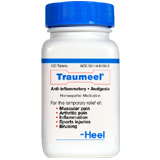
Doctors in Germany compared it to conventional treatment for sprains, strains, and bruises.
First, the details.
- 133 people with musculoskeletal injuries received Truameel (alone or with other homeopathic treatments) or conventional therapy (eg, early mobilization with a bandage for support, compression, anti-inflammatory, anti-pain, anti-coagulant drugs, etc.).
- Symptoms were recorded by the doctors using a 3-pont scale (mild, moderate, severe)
- Dosage and duration of treatment were at the discretion of each doctor.
- Patients were monitored for 3 months.
And, the results.
- 77% and 78% of the Traumeel and conventionally treated patients, respectively, completed the study.
- There were no demographic differences between groups.
- 58% and 56% of the patients in the Traumeel and conventional treatment groups, respectively, achieved complete pain relief.
- 78% and 61% of the patients in each group achieved “cureâ€
- Neither difference was statistically significant
- There was no difference in the time to improvement between groups.
- No side effects were reported with Traumeel, while 6 conventional treatment patients reported side effects that did not lead to further complications.
The bottom line?
This is an all too familiar (and flawed) study design commonly used in Germany. It is full of conflicts of interest. For example, doctors from different practices around the country sign up patients. Then, the same doctors decide which treatment to give each patient — no attempt to randomly assign treatment or to hide the treatment from the patient or doctor (not blinded). Then, the same doctors make the assessments (no independent evaluation) using a technique (questionnaire) that forces patients to tell their doctor whether their doctor chose the correct treatment.
This is the type of study that makes it easy to criticize homeopathy as lacking scientific scrutiny.
One more thing. It’s not clear why anticoagulants (blood thinners) were given to 16% of the patients, whether any of the patients in the conventional treatment group took the anticoagulant with pain medicines such as NSAIDs, and if any side effects in the conventional therapy group were related to bleeding.
5/1/08 21:4 JR